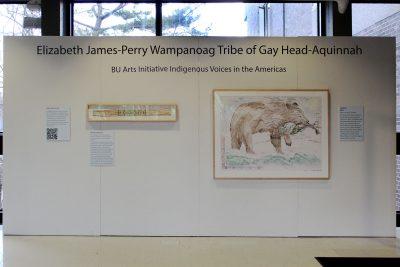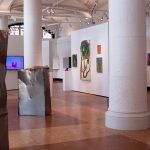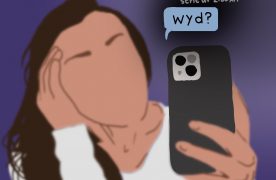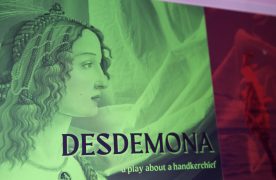Boston University Arts Initiative continues their “Indigenous Voices in the Americas” series this month by displaying the work of internationally known artist Elizabeth James-Perry of the Wampanoag Tribe of Gay Head-Aquinnah in Massachusetts.

The exhibit features two pieces — “MASHQ,” a watercolor painting of a mashq, translated to bear, representing a map of Southern New England, and “Winter Dreams,” a traditional Wampumpeak belt made with quahog shell wampum beads and deerskin warps.
James-Perry said she created the maps to portray the land “as a living entity,” aiming to “get people to think more of the interplay and our dependence and the importance of repreciocity” with it.
A panel beneath “MASHQ” reads, “Native relationship to the northeast is reclaimed by featuring some of the original Native place names,” reflecting the overall message the artist wished to send through her work.
“We’re still here, we’re still connected,” James-Perry said. “We still care about our homelands.”
Through maps, James-Perry “wants to convey the relationality between humans and our homelands instead of portraying the land as this background for human uses, human needs and human lives.”
Managing Director of the BU Arts Initiative, Ty Furman, said speaking about the art and culture of these communities in the present rather than past tense is imperative.
“There are thriving communities that are here now, and that have shown incredible resilience in the midst of systematic racism and colonization,” Furman said.
He also highlighted the talent and craftsmanship displayed by these two pieces.
“This is not Beading 101 at summer camp,” Furman said. “This is a real skill and artistry.”
Besides its beauty, Furman said what he likes most about the art is that it is “both traditional and contemporary.”
“James-Perry’s exhibit is a wonderful mix of that where she did a very traditional Wampanoag belt, but then also a contemporary watercolor map of Massachusetts from her lens as a Wampanoag,” he said.
Administrative Coordinator of the Arts Initiative, Elana Harris, said it was important for the series to “actively engage the student body” and provide an understanding of the “history and how the longevity of from now till then and how it still remains present in today’s culture.”
Tajrir Tahtial, a junior in the College of Communication, said she enjoyed the artwork by James-Perry, especially “MASHQ,” because of how it portrayed the artist’s way to reclaim Native land.
“Programs like this are great for showcasing diversity in the arts and help the campus feel inclusive and open, so I would love for the Arts Initiative to sponsor more of these programs,” she wrote in an email.
Wade Campbell, assistant professor of archaeology and anthropology and member of the Navajo Nation said the series “feels like an important first step.”
“BU hasn’t really ever had a substantial voice on indigenous matters,” he said. “There is this level of specificity that I think a lot of people simply do not appreciate because it’s locked under categories like ‘Indigenous’ or ‘Native’ or ‘Indian.’”
There are more than 570 federally recognized tribes in the United States, Campbell said.
James-Perry said her work can affect the way Native communities are understood by others.
“To people who are just coming to the area, or who are in the area and don’t know much about Native people living in the region and Native communities and Native struggles, it’s a prompt of ‘you can learn about this.’” she said. “We’re still here.”
James-Perry said that art serves an educational role.
“There’s nothing wrong with being decorative or appealing, but I think there’s also aspects to art that challenge people, make them pause, consider a different aspect of something they might have otherwise taken for granted,” she said.
The exhibition will be available for viewing through May on the second floor of the George Sherman Union.













Great article! Beautiful art work.